November 6, 2017
Mary J. Blige and
Carrie Mae Weems
in Conversation:
On Race, Women,
Music and the Future
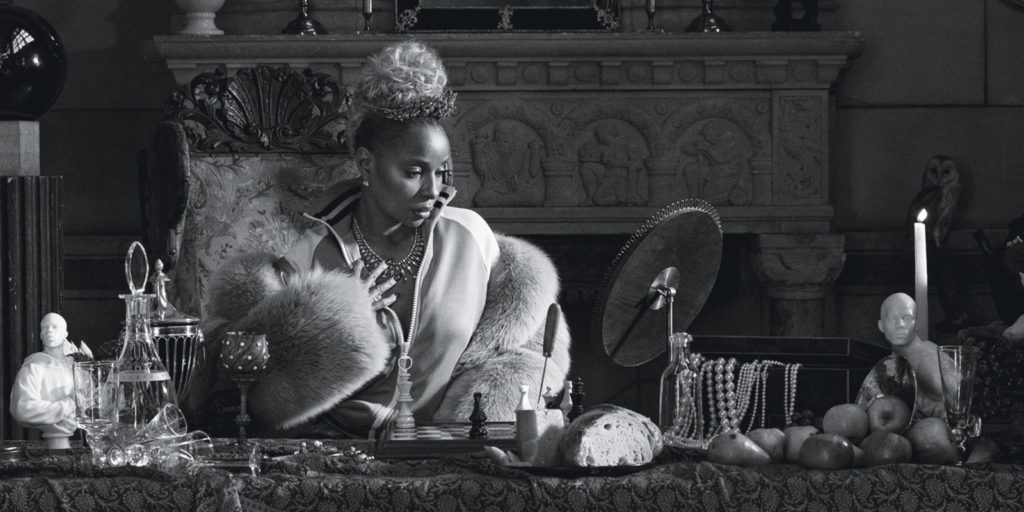
Photographs by Carrie Mae Weems; Styled by Styled by Paul Cavaco. Hair by Kim Kimble for Kimble Hair Care Systems at SixK.LA; makeup by D’Andre Michael for U.G.L.Y. Girl Cosmetics. Set design by Kadu Lennox at Frank Reps. Produced by Carly Day at Rosco Production; Production Coordinator: Marie Robinson at Rosco Production; retouching by silhouette studio; Lighting Director: Rob Kassabian at Honey Artists; Photography Assistants: James Wang, Pamela Vander Zwan, Adger Cowans; Lighting Assistant: David Schinman; Gaffer: Armando Reyes; Fashion Assistants: EJ Briones, nicholas eftaxias; Tailor: Christy Rilling; Set Design Coordinator: Joanna Seitz; Production Assistants: Will Foster, Alejandro Armas, Carl Miller; Special thanks to Dienst + Dotter Antikviteter, Skylight Studios, Pier59 Locations.
Long before female empowerment became a nationwide rallying cry, the artist Carrie Mae Weems and the singer-songwriter Mary J. Blige had their work cut out for them. Weems, who is now 64, first picked up a camera at the age of 18 and over the decades has recast the ways in which black women have been portrayed in images. Early on she realized that she couldn’t count on others to make the pictures she wanted to see. In her seminal work The Kitchen Table Series (1990), she ruminates on race, class, and gender in an unfolding domestic story in which she appears as the protagonist. Shot in black and white, with alternating images and panels of text, the series shows the artist at her kitchen table, alone and with others, seated under a hanging lamp, playing cards, chatting with female friends, and hugging a male partner.
Since that career-defining project, Weems, who lives in Syracuse, New York, has been honored with a MacArthur Foundation “genius grant,” a medal of arts from the U.S. State Department, and numerous museum solo shows, including a retrospective in 2014 at New York’s Guggenheim—the museum’s first-ever survey of an African-American female artist. More recently, in her 2016 series Scenes & Take, she photographed herself standing on the empty stage sets of such TV shows as Empire and Scandal, contemplating the cultural climate that gives rise to commanding black heroines onscreen.
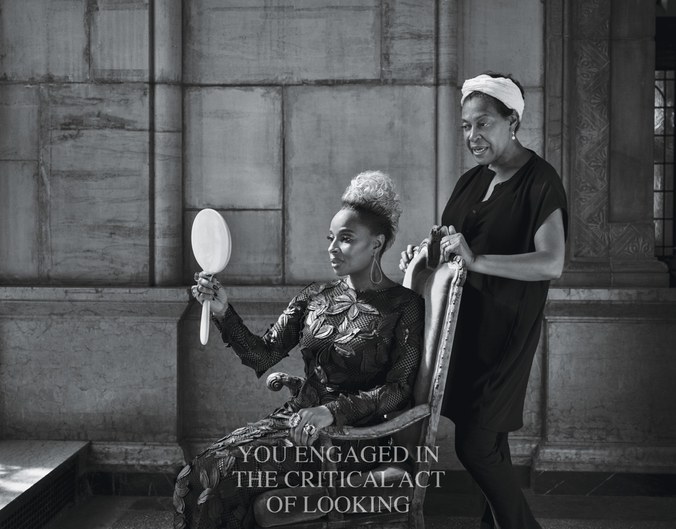
Oscar de la Renta dress; Djula earrings; (right hand, top) Vhernier ring; David Webb rings. Carrie Mae Weems wears her own clothing and jewelry.
In Mary J. Blige, the queen of hip-hop soul, best known for her raw, openly autobiographical songs of empowerment, Weems found a towering ally. Like Weems, the Bronx-born Blige, 46, is a storyteller, and also began her career at 18, when she became the youngest female recording artist to sign with Uptown Records. Her Puff Daddy–produced 1992 debut, What’s the 411?, went multiplatinum, as did many of the hits that followed; so far she’s won nine Grammys. Now she is generating Oscar buzz for her breakout performance in director Dee Rees’s critically acclaimed Mudbound, about two families in the Mississippi Delta during and after World War II, divided by the racism of their Klan-addled community.
Blige is quietly devastating as the wife of a sharecropper and matriarch of a struggling brood; while shooting the film, which will debut on November 17 on Netflix, Blige was dealing with the dissolution of her own marriage. In 2016 she filed for divorce from her husband of 12 years and manager, and emerged with her 13th studio album, Strength of a Woman, which serves as something of an anthem for her life. the New York Times called it “her most affecting and wounded album in several years.”
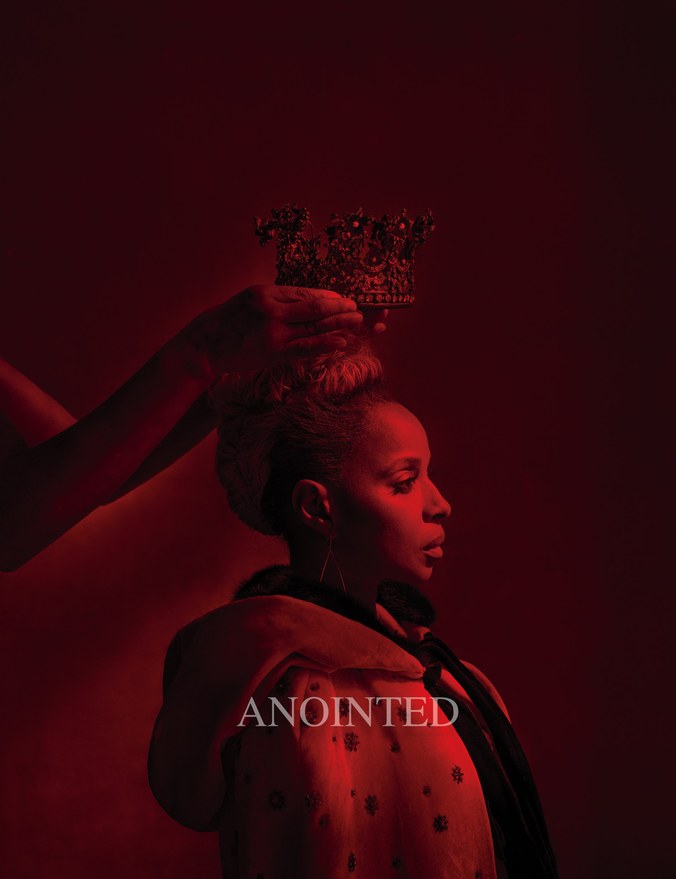
Mary J. Blige wears an Alberta Ferretti cape; Joseph coat; Djula earrings; vintage crown from Early Halloween, New York.
Photographs by Carrie Mae Weems; Styled by Styled by Paul Cavaco.
Both Weems and Blige command the spaces they occupy: Weems with her camera and incantatory style of speech, Blige with her presence and voice. For this project for W’s Art Issue, the two teamed up in a landmark 1920s-era bank building in Brooklyn, making pictures that reference Weems’s The Kitchen Table Series and 2010 Slow Fade to Blackseries, and Blige’s continuing reign.
Carrie Mae Weems: Long before I picked up a camera I was deeply concerned with the ways in which African-Americans were depicted, and, for the most part, I didn’t like what I saw. So one way of dealing with it was to step in and rethink how black women, more specifically, need to be represented. That’s been the guidepost; I’m always on that track. And today I was just looking at another woman, somebody I’ve admired, whose music has been a backdrop to my life. Mary, I see you as an extraordinarily beautiful woman who needs to be defined, described, articulated in an authentic way that celebrates the complexity and depths of your beauty and your internal self. From the moment you walked in, I wanted to greet you personally and invite you into a space of welcome with the understanding that I see me and you.
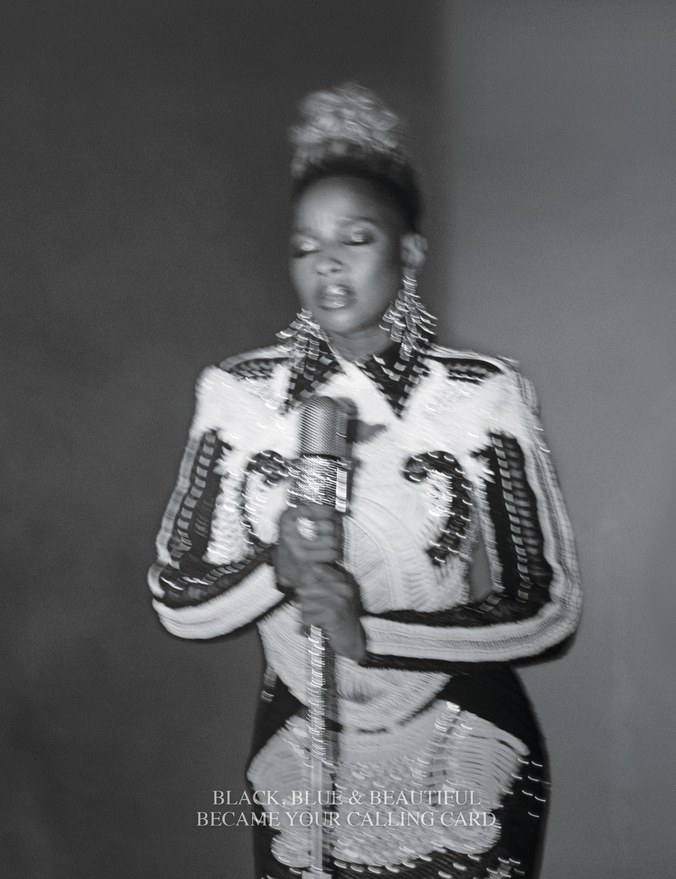
Balmain dress; Jacob & Co. earrings; Munnu the Gem Palace ring.
Photographs by Carrie Mae Weems; Styled by Styled by Paul Cavaco.
Mary J. Blige: Thank you. Same here. A lot of women don’t do that. I don’t see women getting along a lot. In my own circle, I see it because that’s what we do. We want to love on each other, and we want to build each other up, and we want to let each other know what you said just now: We see each other, and we see each other in each other. So I felt protected today, and I felt you cared, which is not always the case in most photo shoots—they just want the pictures. I thought, Okay, I’m going to have to do exactly what she did in order to make this hot. [Both laugh.]
Weems: Those last photographs! Child! I mean, that puppy was smokin’. It felt like the whole day we were ascending. I’m not in the commercial world—I spend 99 percent of my time in my studio by myself—so we were building each thing like interlocking circles so we could go to the next plane. I could feel it coming into a certain kind of flow, and then it became easy. And I thought, Let’s just have fun. There’s a wonderful saying: “Within seriousness there’s very little room for play, but within play there’s tremendous room for seriousness.”
Blige: I didn’t realize how vain I was until I started working on Mudbound. Once I saw how my character, Florence, lived [in a shack on a farm in Mississippi], I thought, Wow, I’m really a vain person. When I went to the movie set to do the first day of fittings, I was Mary J. Blige: I had just done a tour and a show, so I was all, you know, I had wigs and weaves and all sorts of things going on, and Dee Rees was like, “No! We want to see you. You can’t have a perm, you’re going to have minimal, minimal makeup.” And I was like, “What about lashes?” And she said no, and I was like, “Really? Florence doesn’t have lashes?” That part was a lot! A lot! But once I tore away and sunk into the character, Florence actually gave Mary—me, the so-vain person—a little more confidence so that Mary didn’t feel like she needed to depend on all of that. I cut my hair really short. Florence really liberated me. Just committing to and trusting that character kind of helped to save my life. I could also relate to her because she reminded me of my aunts and my grandmother who lived in the South. My mom used to send us to Savannah every summer. My grandmother had her own garden, chickens, cows; so I’ve seen chickens slaughtered, I’ve been on a farm.
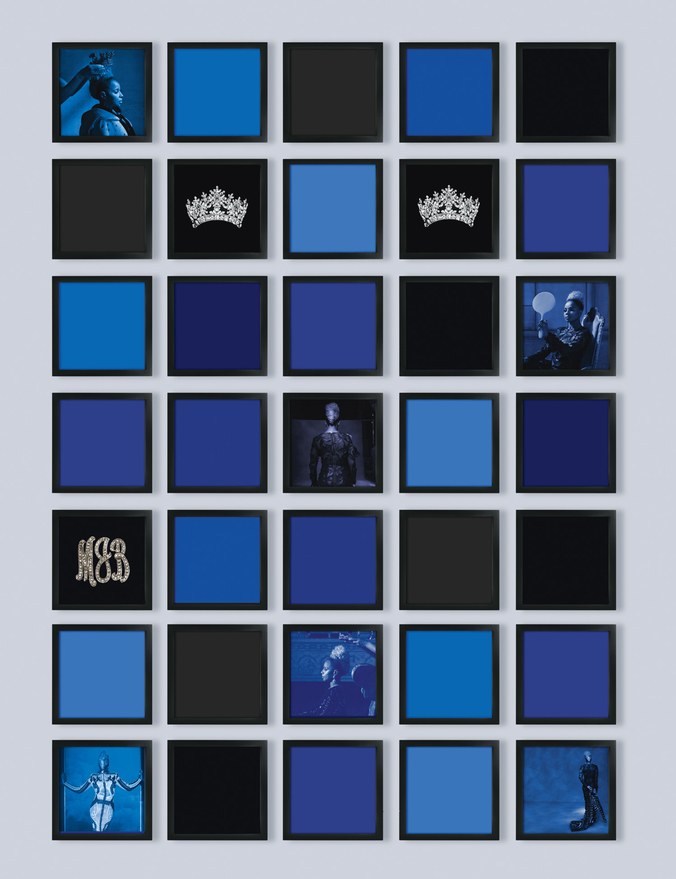
First column from top: Alberta Ferretti cape; Joseph coat. Balmain dress. Third column: Oscar de la Renta dress. Tom Ford dress. Fifth column: Oscar de la Renta dress. Oscar de la Renta dress; Tom Ford coat.
Photographs by Carrie Mae Weems; Styled by Styled by Paul Cavaco.
Weems: You have this film, this history in music. Where do you see yourself going, and what do you want now?
Blige: I want, at some point, to not have to work so hard. I want peace of mind and acceptance of self, totally. I know that’s an ongoing process, so every single day I’m working on that, and it’s been hard ever since this challenge I’m having with this divorce. It was such a terrible thing. It made me see myself as “I have to be better than this”: I was never good enough; I was never pretty enough, smart enough. And there was someone chosen over me. It was like, I can’t stay, but it really let me see, Mary, you are better than that. You have to continue to grow.
Weems: We’ve all been through stuff. And the pain is so deep, but the place it takes you—right? The level of self-reflection—it’s all in the process. Working through that process brings you to a deeper and more profound understanding of who you are and your meaning to yourself.
Blige: Exactly.
Weems: I’m older than you. I work hard every day, and I’m always trying to figure out how not to. But there’s something that’s a part of my DNA that’s about this constant, persistent level of examination. I’m always thinking about the craft, the art, about how to step in, not for the world, but for myself; these are the issues that concern me, and I can’t expect anybody else to deliver on my promise. Right? We were talking about this earlier. No matter what, you’re going to come home by yourself.
Blige: That’s done right now. I’m by myself.
Weems: Mary, I was telling you earlier about this beautiful image I have of [singer] Dinah Washington, who, too, is crowned. The act of crowning is about giving it up, it’s the act of recognition. For this project, I knew that I had to participate in crowning you as a gift and an homage. You are in it, and leading the way. Checkmate.
Blige: Checkmate, yeah!
